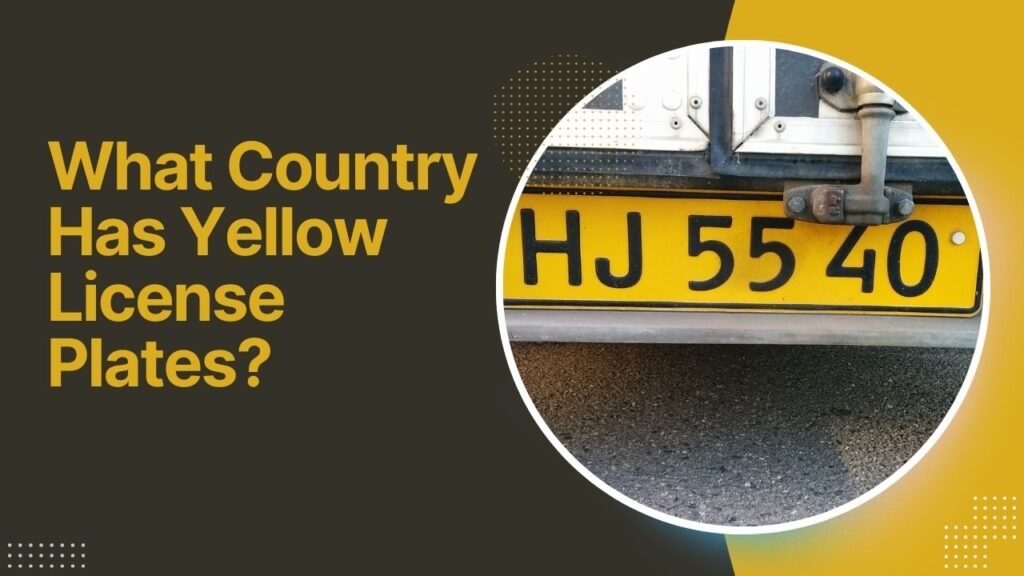States Don’t Require Front License Plates: Have you ever wondered why some cars don’t have a front license plate? It’s because license plate laws change from state to state in the US.
In some states without front license plates, only the rear plate is needed. Others require both front and rear plates.
Knowing these rules is key for drivers to follow local laws and avoid fines. As you learn about the different license plate laws across the country, you’ll understand each state’s unique rules.
Contents
- 1 Current States That Don’t Require Front License Plates
- 2 What States Do Not Require Front License Plates for Vehicles
- 3 Understanding License Plate Laws Across America
- 4 Legal Implications of Missing Front License Plates
- 5 Special Considerations for Different Vehicle Types
- 6 Traveling Between States With Different License Plate Requirements
- 7 Conclusion: States Don’t Require Front License Plates
- 8 FAQ
- 8.1 What are the states that do not require a front license plate?
- 8.2 Are there any specific vehicle types that are exempt from front license plate requirements?
- 8.3 What are the consequences of not having a front license plate in a state where it is required?
- 8.4 How do I comply with license plate laws when traveling across state lines?
- 8.5 Are there any historical reasons why some states don’t require front license plates?
- 8.6 Do license plate laws vary within a state, such as in different counties or cities?
Current States That Don’t Require Front License Plates
Did you know some states don’t need a front license plate? Right now, many states only ask for a rear plate. This gives car owners more freedom.
There are 19 states without a front license plate rule. These include Alabama, Alaska, Arizona, and more. States like Florida, Georgia, and Indiana also don’t require them.
License plate rules can change a lot. Some states need front plates for certain cars. Others have special rules for old or vintage vehicles.
| State | Front License Plate Requirement | Special Conditions |
|---|---|---|
| Alabama | No | Antique vehicles may have different requirements |
| Alaska | No | Off-highway vehicles have separate regulations |
| Arizona | No | Classic cars may require special plates |
Knowing these rules is key to avoid legal trouble. Even in states without a front plate rule, there might be times when you need one.
For the latest info, always check with your state’s DMV or similar agency.
What States Do Not Require Front License Plates for Vehicles
Knowing the rules about license plates is key for car owners in the U.S. The laws about front license plates differ a lot from state to state. This can cause confusion, especially for those who drive across state lines.
Some states don’t need a front license plate on cars. Each state has its own rules about showing license plates. For example, some states might only need a front plate for certain vehicles.
The history of license plate laws in the U.S. started in the early 1900s. At first, there was no standard, so each state had its own rules. Now, there’s a push to make these laws more uniform, but differences still exist.
The table below shows states without front license plates and their rules.
| State | Front License Plate Requirement | Specific Regulations |
|---|---|---|
| Alabama | No | Requires rear license plate only |
| Alaska | No | Requires rear license plate; optional front plate available |
| Arizona | No | Requires rear license plate only |
It’s important for car owners to know the license plate laws in their state. This helps avoid fines and ensures you follow the rules when driving in other states.
As car laws change, it’s vital for owners to keep up with license plate rules.
Understanding License Plate Laws Across America
When you travel across the US, you’ll see that license plate regulations change a lot. Each state has its own rules and preferences.
Some states don’t need a front license plate, while others require both front and rear plates. This can cause confusion, especially for travelers or those moving.
The US license plate rules help authorities identify vehicles. But, the details can differ. For example, some states have special rules for commercial trucks or antique cars.
It’s important to know these rules to follow state laws and avoid fines or penalties. As a vehicle owner or driver, make sure you understand the license plate laws of the states you drive in.
Legal Implications of Missing Front License Plates
Driving without a front license plate in a state that requires it can lead to legal trouble. The penalties vary by location.
In many places, not having a front license plate is a traffic offense. This can cost you between $25 and over $200, depending on where you are. For example, in California, you could face a fine of about $197 for this.

Getting caught without a front plate more than once can mean even bigger fines. In some cases, it could even be a misdemeanor. Plus, if you’re stopped for another reason and don’t have a front plate, you might get more tickets.
It’s crucial to understand that laws about license plates are not just about making money. They help police find cars involved in crimes.
To stay out of trouble, follow your state’s rules about license plates. If you’re not sure what they are, check with your state’s DMV or similar agency. They can help clear up any confusion.
Special Considerations for Different Vehicle Types
Knowing the front plate rules for your vehicle is key. Rules change based on the type of vehicle. For example, commercial vehicles have their own set of rules compared to personal cars.
Commercial vehicles face stricter rules because of their size and use. They must show both front and rear plates and sometimes extra signs for oversized or hazardous loads. Trailers and classic cars also have unique rules. Some states don’t require front plates for classic cars, while trailers might need special plates or decals.
Always check with your state’s DMV to know the rules for your vehicle. You need to know about front plate rules and any extra signs or permits. This way, you can avoid fines or penalties for not following the rules.
In short, different vehicles have different license plate rules. Knowing these rules helps you follow state laws.
Traveling Between States With Different License Plate Requirements
Traveling across the United States means knowing the different license plate laws. This knowledge can help you avoid legal trouble. It’s crucial to understand the rules in each state you visit.
Some important things to keep in mind include:
- Check the license plate laws for each state on your trip.
- Make sure your vehicle meets the local regulations, like displaying a front license plate.
- Know that some states have special rules for visitors that are different from their rules for residents.
- Look up the license plate laws for your destination states before you go.
- Carry proof of your vehicle’s registration and that it meets your home state’s laws.
- Be ready to explain your situation to police if they ask about your license plate.
Being informed and prepared lets you enjoy your US travels without worrying about license plate rules.
Conclusion: States Don’t Require Front License Plates
Navigating license plate laws in the United States can be tricky. Some states don’t need front plates, while others do. Knowing your state’s laws is key to avoiding trouble.
Traveling to states with different plate rules requires you to know the laws. This knowledge helps you avoid fines and penalties. It also saves you time and stress.
Being informed about states without front plates and their laws is crucial. This way, you can drive safely and confidently anywhere in the country. Stay updated with the rules to enjoy your travels.
See Also: Guide to Registering a Vehicle When You’ve Lost the Plate
FAQ
What are the states that do not require a front license plate?
States like Alabama, Alaska, Arizona, and Arkansas don’t need a front plate. Also, Delaware, Florida, and Georgia don’t require it. Idaho, Indiana, and Kansas follow the same rule. Kentucky, Louisiana, and Michigan also don’t need a front plate.
Mississippi, Missouri, and Montana also don’t require a front plate. Nebraska, North Carolina, and North Dakota don’t need one either. Ohio, Oklahoma, and Pennsylvania also don’t require a front plate. South Carolina, Tennessee, and Texas don’t need it either.
Utah, West Virginia, and Wyoming also don’t require a front plate.
Are there any specific vehicle types that are exempt from front license plate requirements?
Yes, some vehicles are exempt. Classic cars, trailers, and commercial vehicles might have different rules. For example, some states require a special permit or a different license plate for these vehicles.
What are the consequences of not having a front license plate in a state where it is required?
Not having a front plate in a required state can lead to fines or penalties. In some cases, your vehicle might even be impounded. The exact consequences depend on the state.
How do I comply with license plate laws when traveling across state lines?
When traveling, check the license plate laws of each state you’ll visit. You might need a temporary permit or ensure your vehicle is registered and has the right plates.
Are there any historical reasons why some states don’t require front license plates?
Yes, the rules on license plates have changed over time. Some states have always not required front plates for various reasons. This includes law enforcement practices and registration rules.
Do license plate laws vary within a state, such as in different counties or cities?
Generally, license plate laws are the same across a state. But, some areas might have their own rules. This could be for toll roads or specific cities.

I’m Karsyn Marsh, a blogger from a small village in Texas. I enjoy writing about many topics, and right now, I’m focused on license plates. I share helpful information and facts on LicensePlateFacts.com.



